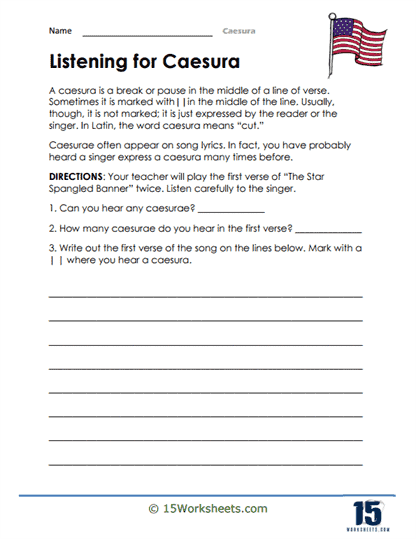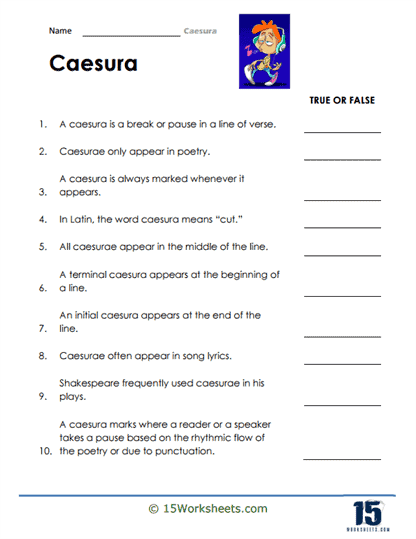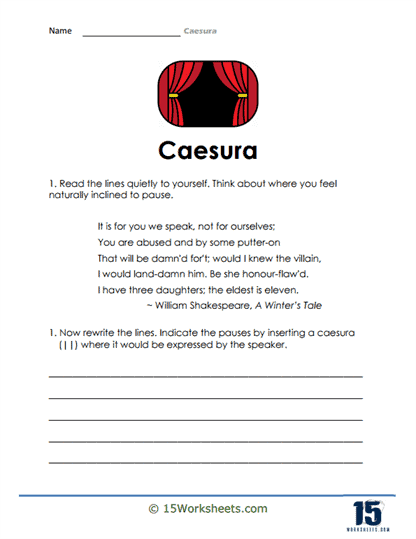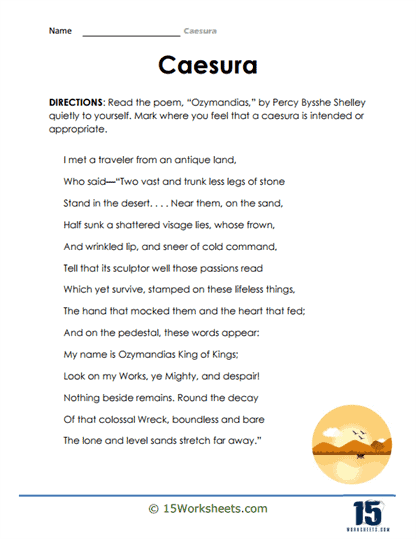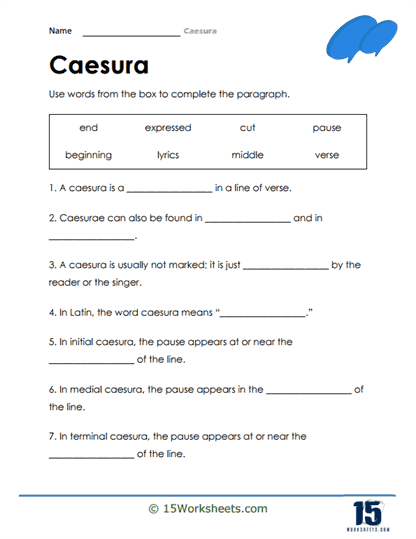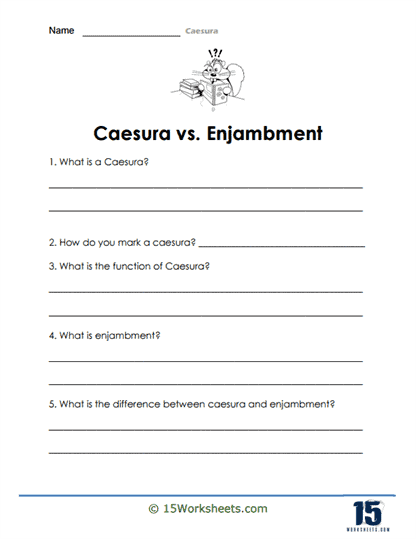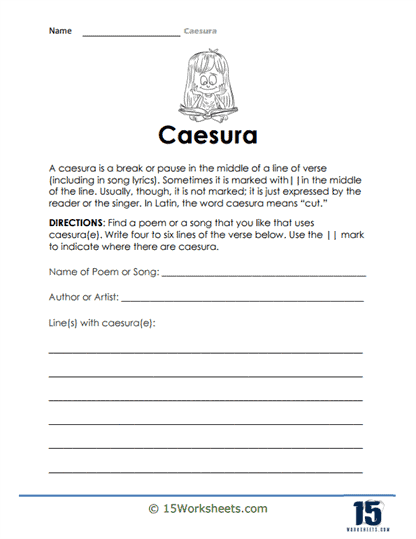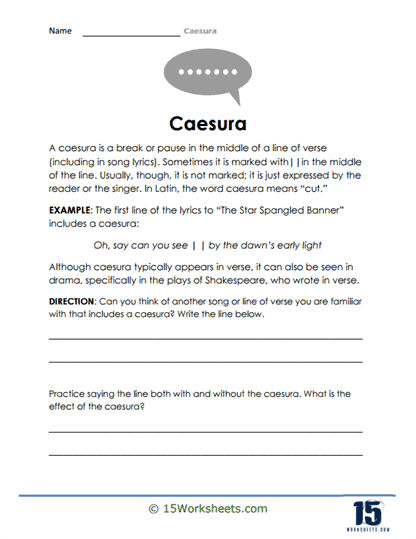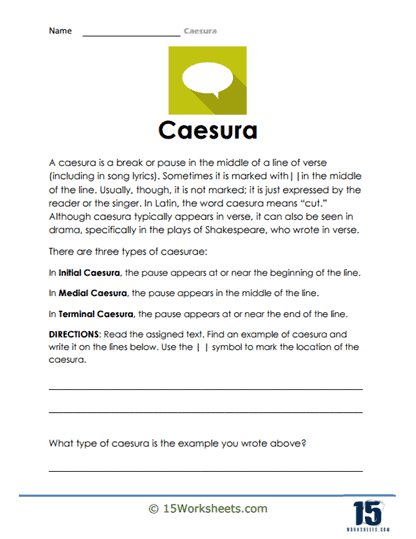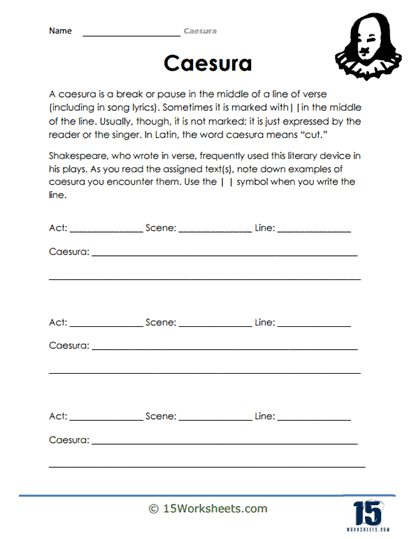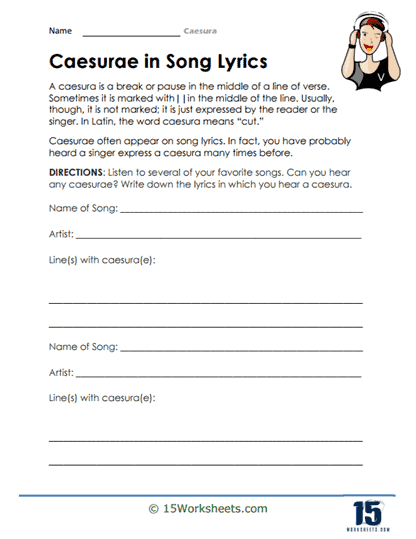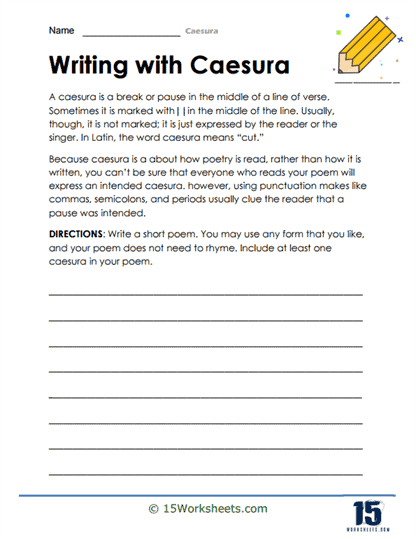Caesura Worksheets
All About These 15 Worksheets
Caesura, a deliberate pause or interruption in a line of poetry, is a subtle yet powerful element of poetic expression. Understanding and effectively utilizing caesura not only deepens a student’s appreciation for the art of verse but also enhances their comprehension, analytical, and creative skills.
In a world where effective communication, emotional expression, and literary insight are highly valued, students must develop the ability to recognize, analyze, and employ caesura to convey complex emotions and ideas. To empower students with the knowledge of caesura and its diverse applications, we proudly present a collection of 15 worksheets. These worksheets are meticulously designed to provide students with structured and engaging opportunities to explore, practice, and master the use of caesura in poetry.
Types Of Exercises In These Caesura Worksheets
Our caesura worksheets were created to help you understand and practice identifying and using caesuras in poetry. Over the course of these worksheets you will find the following types of exercises:
Identification – You will be given lines of poetry and asked to identify where the caesura occurs. This could be marked with a slash (/), a double pipe (||), or some other symbol. The aim of this exercise is to help you understand where and why poets place pauses in their lines.
Write with Caesura – In this exercise, you’d be asked to write your own lines of poetry using caesuras. This would help you understand how caesuras can affect the rhythm and mood of a poem, and give you practice in using them effectively.
Analyze the Effect – You would be given lines or whole poems that use caesura, and asked to write about how the caesura affects the poem. Does it create emphasis? Does it affect the rhythm? Does it contribute to the mood or tone? This exercise would help you deepen your understanding of the purpose and effect of caesura in poetry.
Compare and Contrast – This exercise might provide two versions of the same poem, one with caesuras and one without, and ask you to compare them. How does the presence or absence of caesuras change the poem? This would give you a clear understanding of the impact of caesura on the reading and interpretation of a poem.
Rewrite with Caesura – Similar to writing with caesura, in this exercise, you’d be given a poem or lines from a poem and asked to rewrite them, adding your own caesuras. This allows you to explore creative ways to use pauses to alter the mood, tone, or emphasis in a piece of poetry.
What is Caesura?
Caesura, derived from the Latin word “caesura” meaning “a cutting” or “a slicing,” is a vital literary device often used in poetry. It refers to a pause inserted into a line of verse, deliberately placed by the poet to create a specific rhythmic or dramatic effect. This pause, usually located near the middle of a poetic line, divides the line into two parts and offers a moment of breath or contemplation.
The primary defining feature of a caesura is the pause itself, often marked in scansion by a double vertical line (||), and typically inserted where a natural linguistic pause would occur in speech. Depending on its position within the verse, a caesura can be medial (occurring in the middle of a line), initial (at the beginning), or terminal (at the end). It can also be masculine (occurring after a stressed syllable) or feminine (occurring after an unstressed syllable).
Caesuras are employed by authors to establish a particular rhythm, highlight certain phrases or words, or contribute to the overall mood or tone of the poem. They act as powerful tools to enhance the reading and understanding of a poem, drawing the reader’s attention, and adding a dramatic touch to the verse.
Examples In Literature
“The Waste Land” by T.S. Eliot
Eliot’s landmark modernist poem extensively uses caesura to emphasize the fragmented and disjointed reality it portrays. Consider the line – “April is the cruellest month, || breeding Lilacs out of the dead land.” The caesura, marked by the double vertical line, allows a moment’s pause that emphasizes the stark contrast between the “cruel” nature of April and its act of “breeding Lilacs out of the dead land.”
“My Last Duchess” by Robert Browning
Browning’s dramatic monologue employs medial caesuras to mimic natural speech and create a conversational tone. For example – “That’s my last Duchess || painted on the wall.” Here, the caesura gives the line a rhythm akin to casual talking, enhancing the realism of the Duke’s monologue and drawing readers deeper into the narrative.
“I Wandered Lonely as a Cloud” by William Wordsworth
Wordsworth uses caesuras to reinforce the rhythm of his poem and to allow the reader to pause and visualize the scene he describes. For instance – “For oft, when on my couch I lie || In vacant or in pensive mood.” The caesura here offers a pause for reflection, mirroring the poet’s own contemplative state and enhancing the contemplative atmosphere of the poem.
Caesura is a powerful literary device that serves to shape the rhythm and mood of a poem, enhancing its emotional resonance and readability. By providing a pause for breath or reflection, a caesura can heighten the dramatic impact of a line, underline a particular image or emotion, or simply offer a moment of respite within the flow of the verse. As such, understanding and recognizing the use of caesura in poetry can greatly enhance one’s appreciation and interpretation of a poem, revealing layers of meaning and artistry that might otherwise go unnoticed.
The Importance of Understanding Caesura For Students
Understanding caesura and its various forms is of great importance for several reasons:
- Poetic Appreciation: Caesura is a fundamental element of poetic form, contributing to the rhythm, tone, and structure of verse. Recognizing caesura enhances students’ appreciation of poetry as an art form.
- Comprehension: Identifying and analyzing caesura helps students comprehend the meaning and nuances of poetry, as pauses often signal shifts in thought or emphasis.
- Creative Expression: Proficiency in understanding and employing caesura sharpens students’ creative writing skills, allowing them to use pauses strategically in their own poetry and prose.
- Literary Analysis: Recognizing and analyzing caesura in poetry deepens students’ ability to interpret and discuss literary works, fostering critical thinking and literary insight.
This collection of Caesura worksheets is a valuable resource for educators and parents committed to nurturing poetic appreciation, creative expression, and literary analysis skills in students. Proficiency in recognizing, analyzing, and employing caesura equips individuals with the tools to engage with poetry on a profound level, appreciate the role of rhythm and pause in language, and craft compositions that convey complex emotions and ideas.
This collection is an investment in their future success, ensuring they have the skills to appreciate and create poetry that breaks the silence with deliberate and resonant pauses, contributing to the ongoing conversation of human expression in a world where the art of verse continues to enrich our lives and emotions. Embrace these worksheets today, and watch your students become discerning interpreters and skilled creators of poetry that embraces the power of caesura.



